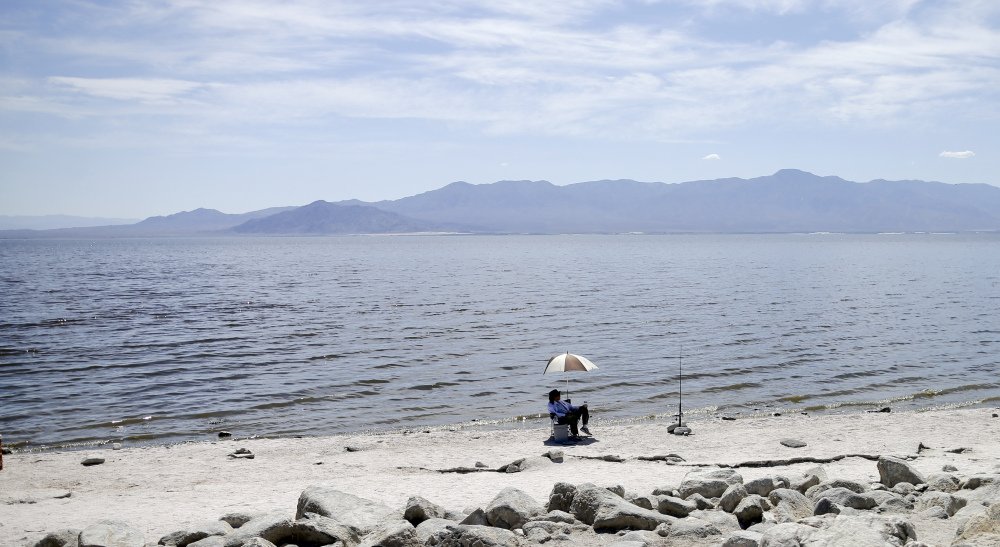SALTON CITY, Calif. — Once-bustling marinas on shallow water in California’s largest lake a few years ago are bone-dry. Carcasses of oxygen-starved tilapia lie on desolate shores. Eared grebes and shoreline birds bob up and down to feast on marine life.
An air of decline and strange beauty permeates the Salton Sea: The lake is shrinking – and on the verge of getting much smaller as more water goes to coastal cities.
San Diego and other Southern California water agencies will stop replenishing the lake after 2017, raising concerns that dust from exposed lakebed will exacerbate asthma and other respiratory illness in a region whose air quality already fails federal standards. A smaller lake also threatens fish and habitat for more than 400 bird species on the Pacific flyway.
Many of the more than 10,000 people who live in shoreline communities cherish the solitude but now feel forgotten. The dying lake must compete for water as California reels from a four-year drought that has brought sweeping, state-ordered consumption cuts.
Julie Londo, who moved to Salton City in 1986, hopes for help for the periodic, rotten odor from the lake that keep residents inside on hot, fly-filled summer nights. The stench in 2012 carried more than 150 miles to Los Angeles.
“Unfortunately, that’s the only time anyone will listen because we don’t have a voice,” Londo, 60, said. “You can scream all you want. Nobody cares.”
UNQUENCHED DEMAND FOR WATER
San Diego buys more than one-quarter of its water from the Imperial Valley, where fields produce runoff that delivers 70 percent of the lake’s inflows. More water for San Diego means less for the Salton Sea.
In 2003, the state Legislature agreed to spearhead efforts to restore the lake to help seal the San Diego sale. California, which used more Colorado River water than it was entitled to, was under enormous pressure to go on a water diet.
The San Diego County Water Authority and other local agencies agreed to deliver water to the Salton Sea for 15 years while the state developed a long-term fix. This year, that water accounts for 10 percent of the lake’s inflows.
With no fix in sight, the Imperial Irrigation District asked state regulators in November to condition San Diego sales on the state fulfilling its promise, citing the state legislation and the state’s open-ended contractual commitment to pay for offsetting environmental damage.
The 2003 contract to sell water to San Diego for up to 75 years still divides Imperial Valley farmers, who grow much of the nation’s winter vegetables.
THE ACCIDENTAL SEA
Imperial Valley gets nearly 20 percent of Colorado River water distributed in the western United States and northern Mexico – enough for more than 6 million households – but some growers fear cities will eventually suck their fields dry.
Bruce Kuhn, who cast the deciding vote for the San Diego sale as a board member of the Imperial Irrigation District in 2003, said he would have opposed the deal without the state’s pledge to the Salton Sea.
Kuhn lost his re-election bid; revenues at his farm services business slid about one-third. “It cost me business and it cost me friends,” he said.
The lake is often called “The Accidental Sea” because it was created in 1905 when the Colorado River breached a dike and two years of flooding filled a sizzling basin that today is about 35 miles long, 15 miles wide and only 50 feet deep. The lak would have quickly evaporated if farmers hadn’t settled California’s southeastern corner.
The lake has suffered a string of catastrophes since tropical storms in the late 1970s destroyed houses, marinas and yacht clubs, ending an era of international speedboat races and glamor that once drew more visitors than Yosemite National Park. Botulism killed many pelicans in 1996.
The water is nearly twice as salty as the Pacific Ocean, endangering remaining tilapia. Winds that stir hydrogen sulfide gas from the lake’s bottom strips oxygen from surface waters where fish swim and creates stenches similar to rotten eggs.
The nonprofit Pacific Institute estimates that surface area of the 350-square-mile lake will shrink 100 square miles by 2030, salinity will triple over 15 years, and fish will disappear in seven years without intervention. San Diego’s water purchases from Imperial Valley – which ramp up to 2021 – are to blame but low rainfall and water conservation also hurt.
Copy the Story LinkSend questions/comments to the editors.



Success. Please wait for the page to reload. If the page does not reload within 5 seconds, please refresh the page.
Enter your email and password to access comments.
Hi, to comment on stories you must . This profile is in addition to your subscription and website login.
Already have a commenting profile? .
Invalid username/password.
Please check your email to confirm and complete your registration.
Only subscribers are eligible to post comments. Please subscribe or login first for digital access. Here’s why.
Use the form below to reset your password. When you've submitted your account email, we will send an email with a reset code.